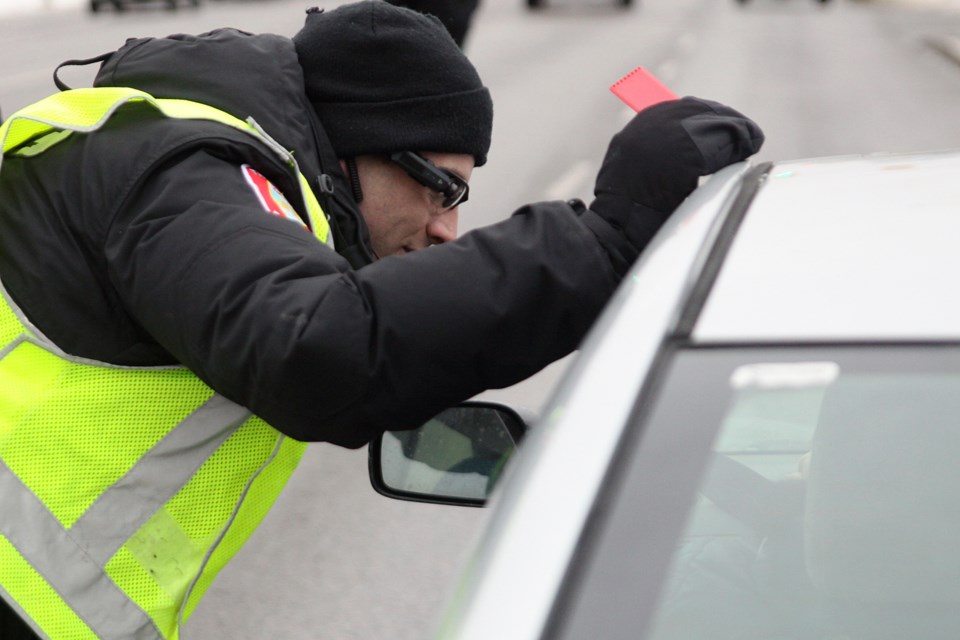THUNDER BAY - The number of drivers stopped for drug-impaired driving offences is on the rise in the city, which reflects both increasing enforcement by the Thunder Bay Police Service as well as the ongoing opioid crisis.
“Our impaired numbers in 2020 did rise significantly,” said Thunder Bay Police Service Traffic Unit Acting Sgt. Sal Carchidi. “We prosecuted 299 individuals for impaired driving related offences, 48 per cent of those were drug-driving related offences and I think that speaks to the addictions issues in our city.”
The statistics were part of the Thunder Bay Police Service traffic management plan for 2021-22 that was presented to the Thunder Bay Police Services Board during its monthly meeting on Tuesday.
Based on the numbers, Thunder Bay has one of the highest per capita rates of impaired driving in Ontario, with 111 impaired drivers per 100,000 people in 2016, with the number this year on par.
According to Carchidi, the majority of drug-related impairments involve opioids and other narcotics, while cannabis accounts for very few despite its legalization in 2018.
“In relation to the opioids, our officers are responding to many calls where people are literally passed out behind their wheel, either while driving or stopped at an intersection or in a parking lot,” Carchidi said.
“With every high or euphoric phase of a drug there is also a crash phase and that is a key indicator in impaired drivers, droopy eyelids, slurred speech, and fatigue.”
Carchidi said it is difficult to determine if the number of drug-impaired drivers is actually increasing or if enhanced enforcement following the legalization of cannabis is leading to better detection.
“We would attribute it to our officer’s interdiction skills for being able to identify those drivers under the influences of drugs and alcohol,” he said.
“We’ve increased training in our drug recognition experts, as well as our standardized field sobriety testers. We now have 60 officers trained in standard field sobriety testing, which also allows them to identify the drivers possibly impaired, conduct a roadside test, and bring them before a drug recognition expert.”
As part of the traffic management plan, enforcement with continue with enhanced training for frontline officers to detect impaired drivers.
Carchidi added that fortunately, drug or alcohol-impaired driving has not resulted in an increase in serious injuries or fatalities on area roadways, with only one serious collision being investigated last year involving impairment.
“Fortunately for us those drivers are either not being involved in those collisions or we are stopping them prior to being involved in those collisions,” he said.
However, the traffic management plan did highlight that collisions are city roads have been increasing steadily over the last five years.
With the exception of 2020 that saw a significant decline in collisions due to fewer cars being on the road during the pandemic, the average number of collisions between 2015 and 2020 was 424.
In the past five years, there has been 16 fatalities and 20,227 collisions, 17,667 without injuries and 2,544 with injuries.
According to the report, the Thunder Bay Police investigate nearly 10 collisions per day on a yearly average.
“Unfortunately, it’s attributed to driver behaviour,” Carchidi said.
“Everyone seems to be in a rush from time to time. So the main reason we are seeing collisions in Thunder Bay is driver behaviour, either speeds too fast, following too close, failure to yield, or improper turns at intersections. The bump in our numbers are driver error or driver actions.”
Going forward, the traffic unit will continue to enforce aggressive and distracted driving laws, remove suspended drivers and uninsured vehicles from the road, and continuing to collect data on high-risk intersections.
“Between our services statistics and the collision reporting centre, we identify the top 10 high collision intersections in the city per quarter,” Carchidi said. “We then conduct targeted enforcement to try and curb drivers bad behaviour at this high-risk intersections.”
The Thunder Bay Police traffic unit has also recently acquired new traffic data collection technology known as Black Cat.
The Black Cat can be affixed to any light fixture or pole and collect data for approximately a week on a given street.
Carchidid said based on the data, the traffic unit can identify areas where speeding is an issue and uniformed patrol officers can then increase enforcement of traffic laws.
